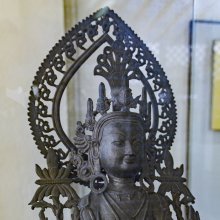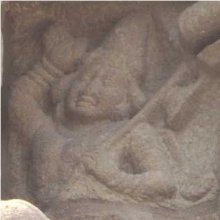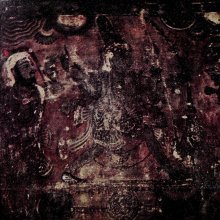Kinnari, Kinnarī, Kimnari, Kiṉṉari: 7 definitions
Introduction:
Kinnari means something in Buddhism, Pali, Hinduism, Sanskrit, Marathi, Jainism, Prakrit, Tamil. If you want to know the exact meaning, history, etymology or English translation of this term then check out the descriptions on this page. Add your comment or reference to a book if you want to contribute to this summary article.
Images (photo gallery)
In Hinduism
Purana and Itihasa (epic history)
Source: archive.org: Shiva Purana - English TranslationKinnarī (किन्नरी) refers to a group of deities, according to the Śivapurāṇa 2.2.22. Accordingly as Brahmā narrated to Nārada:—“[...] On the top of the mountain near the city of Himālaya (śailarājapura), Śiva sported about for a long time in the company of Satī. [...] Many kinds of semid-ivine beings the Aśvamukhas, the Siddhas, the Apsaras, the Guhyakas, etc. roamed there. Their women-folk, the Vidyādharīs, the Kinnarīs and the mountain lasses played about here and there. The celestial damsels played on their lutes, tabours and drums and danced with enthusiasm.”.

The Purana (पुराण, purāṇas) refers to Sanskrit literature preserving ancient India’s vast cultural history, including historical legends, religious ceremonies, various arts and sciences. The eighteen mahapuranas total over 400,000 shlokas (metrical couplets) and date to at least several centuries BCE.
In Buddhism
Tibetan Buddhism (Vajrayana or tantric Buddhism)
Source: academia.edu: The Structure and Meanings of the Heruka MaṇḍalaKinnarī (किन्नरी) is the name of a Ḍākinī who, together with the Vīra (hero) named Kinnara forms one of the 36 pairs situated in the Ākāśacakra, according to the 10th century Ḍākārṇava chapter 15. Accordingly, the ākāśacakra refers to one of the three divisions of the dharma-puṭa (‘dharma layer’), situated in the Herukamaṇḍala. The 36 pairs of Ḍākinīs [viz., Kinnarī] and Vīras are dark blue in color; they each have one face and four arms; they hold a skull bowl, a skull staff, a small drum, and a knife. Alternatively, the Ḍākinīs have their own marks and motions according to the taste instead of a small drum and a skull staff.

Tibetan Buddhism includes schools such as Nyingma, Kadampa, Kagyu and Gelug. Their primary canon of literature is divided in two broad categories: The Kangyur, which consists of Buddha’s words, and the Tengyur, which includes commentaries from various sources. Esotericism and tantra techniques (vajrayāna) are collected indepently.
Languages of India and abroad
Pali-English dictionary
Source: BuddhaSasana: Concise Pali-English Dictionarykinnarī : (f.) a kinnara woman.

Pali is the language of the Tipiṭaka, which is the sacred canon of Theravāda Buddhism and contains much of the Buddha’s speech. Closeley related to Sanskrit, both languages are used interchangeably between religions.
Marathi-English dictionary
Source: DDSA: The Molesworth Marathi and English Dictionarykinnarī (किन्नरी).—f (S) A particular musical instrument. 2 A female chorister or musician in svarga.
Marathi is an Indo-European language having over 70 million native speakers people in (predominantly) Maharashtra India. Marathi, like many other Indo-Aryan languages, evolved from early forms of Prakrit, which itself is a subset of Sanskrit, one of the most ancient languages of the world.
Prakrit-English dictionary
Source: DDSA: Paia-sadda-mahannavo; a comprehensive Prakrit Hindi dictionaryKiṃnarī (किंनरी) in the Prakrit language is related to the Sanskrit word: Kinnarī.
Prakrit is an ancient language closely associated with both Pali and Sanskrit. Jain literature is often composed in this language or sub-dialects, such as the Agamas and their commentaries which are written in Ardhamagadhi and Maharashtri Prakrit. The earliest extant texts can be dated to as early as the 4th century BCE although core portions might be older.
Sanskrit dictionary
Source: DDSA: Paia-sadda-mahannavo; a comprehensive Prakrit Hindi dictionary (S)Kinnarī (किन्नरी) in the Sanskrit language is related to the Prakrit word: Kiṃnarī.
Sanskrit, also spelled संस्कृतम् (saṃskṛtam), is an ancient language of India commonly seen as the grandmother of the Indo-European language family (even English!). Closely allied with Prakrit and Pali, Sanskrit is more exhaustive in both grammar and terms and has the most extensive collection of literature in the world, greatly surpassing its sister-languages Greek and Latin.
Kannada-English dictionary
Source: Alar: Kannada-English corpusKinnari (ಕಿನ್ನರಿ):—
1) [noun] a female belonging to the category of mythical beings in human form with the head of a horse.
2) [noun] an old stringed instrument similar to lute.
Kannada is a Dravidian language (as opposed to the Indo-European language family) mainly spoken in the southwestern region of India.
See also (Relevant definitions)
Starts with: Kinnarigal, Kinnarigallu, Kinnarikayi, Kinnarikriye, Kinnarivine.
Ends with: Kivudukinnari.
Full-text (+39): Kinnara, Raktadhara, Kunti, Kinneri, Kinnarabhave, Kinnuri, Rathavati, Kinnarikayi, Kinnarikriye, Pandaraka, Tonaga, Ashvamukhi, Lakshmimdada, Satataparigrahadharmakankshini, Shrikimnarijataka, Dhatupriya, Subhushanabhushita, Malaka, Mahavaruna, Candalaka.
Relevant text
Search found 34 books and stories containing Kinnari, Kinnarī, Kimnari, Kiṃnarī, Kiṉṉari; (plurals include: Kinnaris, Kinnarīs, Kimnaris, Kiṃnarīs, Kiṉṉaris). You can also click to the full overview containing English textual excerpts. Below are direct links for the most relevant articles:
The Mahavastu (great story) (by J. J. Jones)
Chapter XIII - The Kinnarī Jātaka < [Volume II]
Chapter XX - Śyāmaka Jātaka < [Volume II]
Chapter XLIII - The Jātaka of Uruvilvā-Kāśyapa, Nadī-Kāśyapa and Gayā-Kāśyapa < [Volume III]
Tibetan tales (derived from Indian sources) (by W. R. S. Ralston)
Pallava period (Social and Cultural History) (by S. Krishnamurthy)
Stringed instruments (Tata) < [Chapter 4 - Material Culture of the People]
Musical Instruments (Introduction) < [Chapter 4 - Material Culture of the People]
Solid instruments (Ghana) < [Chapter 4 - Material Culture of the People]
Maha Prajnaparamita Sastra (by Gelongma Karma Migme Chödrön)
Story of the Kiṃnarī and the five hundred ṛṣis (2) < [Part 5 - The virtue of meditation]
Section A.2 - Rejection of pleasant sounds < [Part 2 - Means of acquiring meditation]
Appendix 7 - The Legend of Druma (king of the Gandharvas) < [Chapter XV - The Arrival of the Bodhisattvas of the Ten Directions]
Garga Samhita (English) (by Danavir Goswami)
Verse 2.18.35 < [Chapter 18 - The Sight of Śrī Kṛṣṇacandra]
Ramayana (by Manmatha Nath Dutt)
Chapter XVII < [Book 1 - Bāla-kāṇḍa]
Related products



